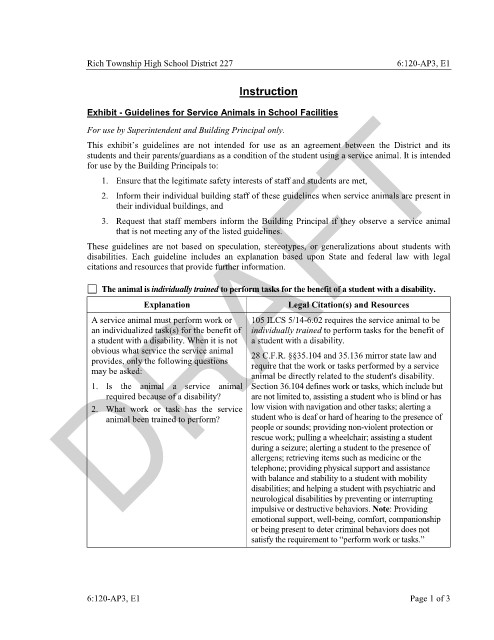Page 1005 - draft
P. 1005
Rich Township High School District 227 6:120-AP3, E1
Instruction
DRAFT
Exhibit - Guidelines for Service Animals in School Facilities
For use by Superintendent and Building Principal only.
This exhibit’s guidelines are not intended for use as an agreement between the District and its
students and their parents/guardians as a condition of the student using a service animal. It is intended
for use by the Building Principals to:
1. Ensure that the legitimate safety interests of staff and students are met,
2. Inform their individual building staff of these guidelines when service animals are present in
their individual buildings, and
3. Request that staff members inform the Building Principal if they observe a service animal
that is not meeting any of the listed guidelines.
These guidelines are not based on speculation, stereotypes, or generalizations about students with
disabilities. Each guideline includes an explanation based upon State and federal law with legal
citations and resources that provide further information.
The animal is individually trained to perform tasks for the benefit of a student with a disability.
Explanation Legal Citation(s) and Resources
A service animal must perform work or 105 ILCS 5/14-6.02 requires the service animal to be
an individualized task(s) for the benefit of individually trained to perform tasks for the benefit of
a student with a disability. When it is not a student with a disability.
obvious what service the service animal 28 C.F.R. §§35.104 and 35.136 mirror state law and
provides, only the following questions require that the work or tasks performed by a service
may be asked: animal be directly related to the student's disability.
1. Is the animal a service animal Section 36.104 defines work or tasks, which include but
required because of a disability? are not limited to, assisting a student who is blind or has
2. What work or task has the service low vision with navigation and other tasks; alerting a
animal been trained to perform? student who is deaf or hard of hearing to the presence of
people or sounds; providing non-violent protection or
rescue work; pulling a wheelchair; assisting a student
during a seizure; alerting a student to the presence of
allergens; retrieving items such as medicine or the
telephone; providing physical support and assistance
with balance and stability to a student with mobility
disabilities; and helping a student with psychiatric and
neurological disabilities by preventing or interrupting
impulsive or destructive behaviors. Note: Providing
emotional support, well-being, comfort, companionship
or being present to deter criminal behaviors does not
satisfy the requirement to “perform work or tasks.”
6:120-AP3, E1 Page 1 of 3

